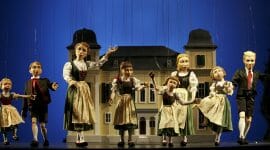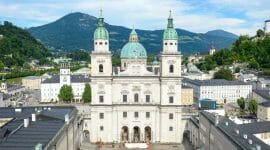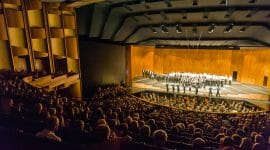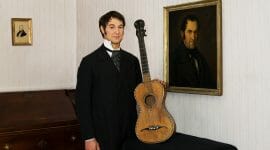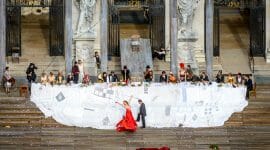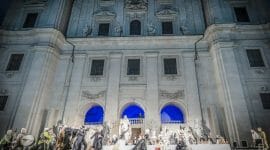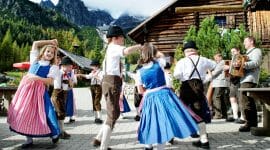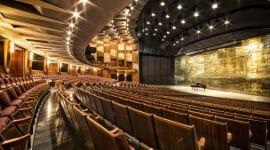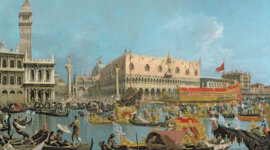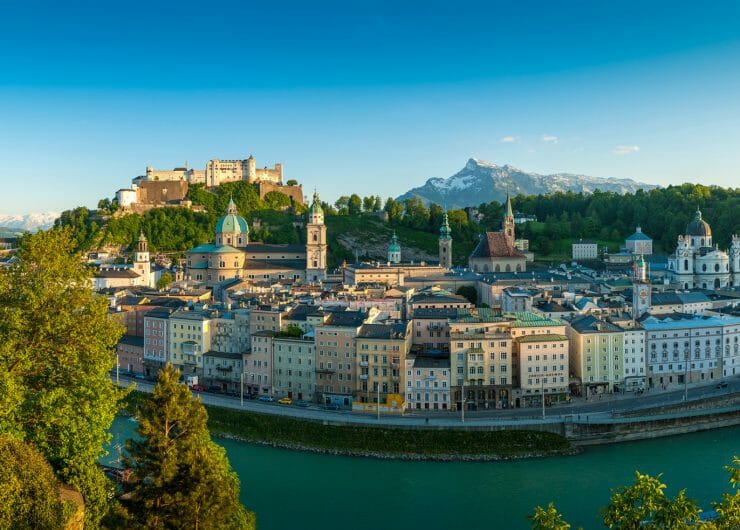
The Festival district
- Hofstallgasse: VIPS and Paparazzi: The red carpet is rolled out, it’s Festival time. The wide Hofstallgasse between the Festival Hall and Faculty of Catholic Theology witnesses an unusual extravaganza every year. Limos and sports cars drive VIPS right up to the red carpet. Onlookers on the other side of the street wait with their cameras and discuss current rumours while trying to catch a glimpse of them.
- Furtwängler Park: The adjacent Furtwängler Park gets turned into a luxury car park, an open-air café and a Prosecco party for Festival guests and employees alike. You can hear the latest stories or find out before everyone else whether Everyman is going to be performed inside or outside on that day – as long as you have the right sources …
- Domplatz: The huge stage and tribune for the Everyman performances dominate the historic centre during the Salzburg Festival. If the weather is uncertain, then everything is set up in the Large Festival Hall as well as in front of the cathedral and then later dismantled. In the last few years, the entire Everyman procession has walked from the Festival Hall to the stage – a festive procession you shouldn’t miss if you are in the area.
- Kapitelplatz: Not everyone has the money, ticket luck or the patience to watch an opera production at the Large Festival Hall. For several years now, the Siemens Fest>Spiel>Nächte has been showing the best shows of the last few years on a big screen. Locals bring their own drinks to this public screening, which has also become a part of the Festival’s tradition – and visitors are welcome to do, too.
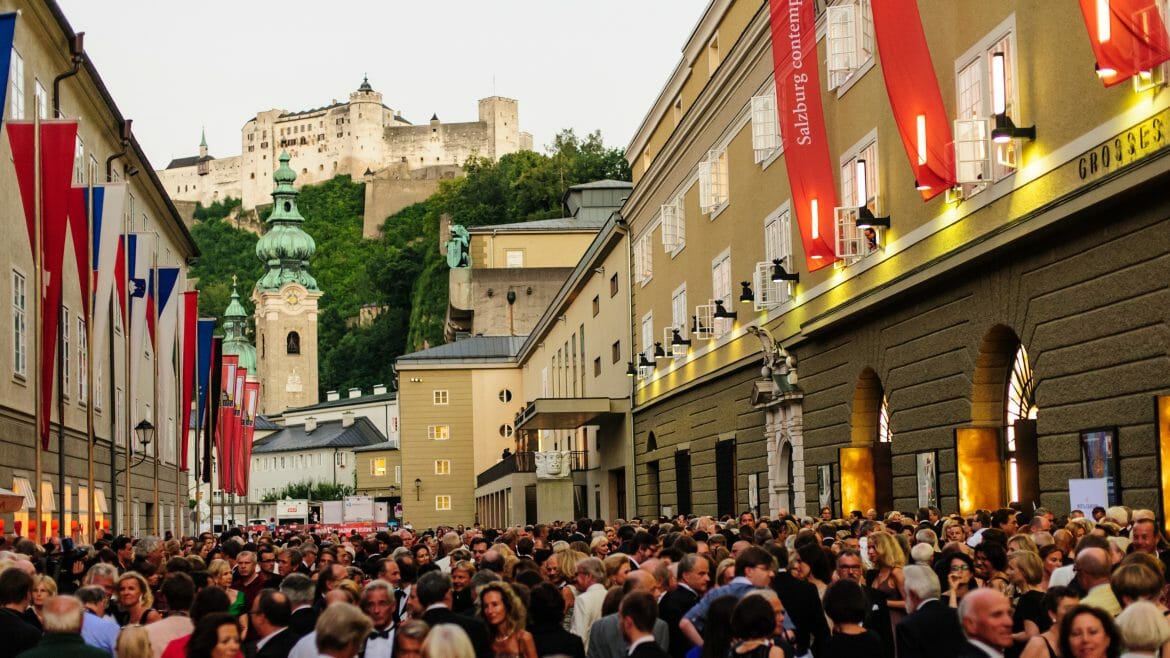
© Tourismus Salzburg GmbH, Bryan Reinhart – Salzburg Festival
Selected locations of the Salzburg Festival
Large Festival Hall: The big challenge in the construction of the Large Festival Hall was to build a theatre house with an opera stage between the three hundred-year-old facade of the former Prince-Bishop’s Hofmarstalles and the Mönchsberg Mountain. The plans are primarily based on the work of the “Festival” architect Clemens Holzmeister. On the 26th July 1960, the Large Festival Hall was opened with a ceremony and a performance of Richard Strauss’s “The Knight of the Rose” under the musical direction of Herbert von Karajan. The almost square floor plan of the auditorium with approx. 35 metres length offers ideal acoustic and visual conditions for 2,179 visitors from the ground floor up to the circle.
The Felsenreitschule: This once served as a conglomerate quarry for the construction of the Salzburg Cathedral until, at the end of the 17th century Archbishop Johann Ernst Thun ordered its reassignment. He had 96 three-storey arcades smashed into the walls of the abandoned quarry in order to allow observing of equestrian demonstrations and animal fights from here. Early in the 20th century, Max Reinhardt suggested that the former winter riding school (now The Karl-Böhm-Saal) and the Felsenreitschule be transformed into a theatre. In 1926, he used the Felsenreitschule for the first time for a production as part of the Salzburg Festival.
House for Mozart: On the site of the former Great Winter Riding School, a temporary Festival Hall was opened in 1925, which over the decades has undergone numerous adaptations. The so-called “Little Festival Hall” was converted into the modern and attractive House for Mozart in three construction phases up to the Mozart year of 2006. It delivers optimal acoustics, great visibility and 1,580 seats with sufficient capacity and yet intimacy. Info: The Festival Halls can be visited daily as part of public tours (daily at 2 p.m.). Group tours are possible upon prior reservation.
Leopoldskron Palace: The “Cradle of the Salzburg Festival”. The idyllically located Leopoldskron Palace was built in the first half of the 18th century as the family seat of Archbishop Leopold Anton Firmian and is considered to be the “Cradle of the Salzburg Festival”. Here in 1920, together with Hugo von Hofmannsthal and Richard Strauss, Max Reinhardt founded the most important music and theatre festival in the world. For twenty years, this grandiose baroque complex served as a residence for the founder of the festival, although when he acquired it in April 1918, it was in a dilapidated state. Max Reinhardt renovated parts of the palace and brought it to life with his theatre productions and many friends and guests. Artists, musicians, writers and actors gathered in Salzburg to establish a new era. But soon, new political developments cast great shadows and in 1938 the castle was confiscated by the Nazi government, Max Reinhardt was dispossessed. He never returned to Leopoldskron. Since 1947, Leopoldskron Palace has been home to the “Salzburg Global Seminar” educational institution. In 1964, Hollywood used the romantic setting as the filming location for the world-famous film “The Sound of Music”. Special tip: Today, Leopoldskron Palace and the park are only accessible to guests of the “Hotel Schloss Leopoldskron” as well as conference and event participants. As part of “Zum Fest” the Salzburg Festival invites visitors to Leopoldskron Palace with “The World of Yesterday” (6th to 9th August 2020) on a very special journey through time into the important history of the building.
Crowds in the city
Summer is the peak tourist season. If you can, try and avoid the historic centre on very hot days. Or simply escape to the coffee houses in the cool passageways on Getreidegasse. It’s also not the best idea to visit the main sites and attractions in the city when the Festival is on as there are long waiting times and masses of people. It’s best to take public transport when coming into town but if you’re coming by car, allow for plenty of time to find a parking space.
Nevertheless, you have to experience the Salzburg Festival at least once. Be it at the live performances or simply the hustle and bustle while strolling through the city.



